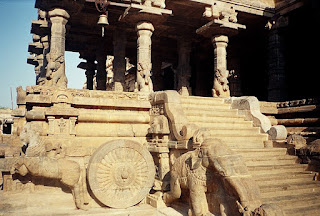Chariot run or rath yatra, an essential part of festival tradition in many temples of India is more prominent in states like Tamil Nadu, Karnataka, Andhra and Odisha than other states.The annual festival event is observed with devotion, pomp and gaiety by the devotees. What is special about temple chariots or Ther (in Tamil) is they represent the intangible heritage and various aspects of temple architecture that evolved over a long period of time particularly, after medieval times. The ancient concept of Ratha gave inspirations to the temple builders to construct temples on the model of a ratha with a sanctum and vimana or shigara over it. Additional parts like mandapa. pradakshina path, entrance gate with gopura, etc., evolved gradually.
 |
| decorated temple chariot with wooden base .flickr.com |
Hindu Temples are designed and constructed as models of the cosmos - holonomic and similar in nature. The wooden base with 4 wheels and the platform represent five boothas - five elements of nature that has space-continuum aspect. It also has intricate wooden carvings highlighting stories from the Hindu epics the Ramayana and Mahabharata, besides many deities in the Hindu Pantheon. The moving wheels suggest transient aspect of nature and time. The philosophical connotation is journey through life is not an easy one -it is a sort of seesaw struggle at every phase.
There are different types of ratha and the important ones are:
Pushya Ratha- For processions of kings.
Kreeda Ratha- For competitions and races.
Sangramik Ratha- For wars.
Deva Ratha- For Gods.
Linking with countless hymns and epics, the vision resulted in the stone carving of chariots in many famous temples such as Vijaya Vitala temple of Humpi, Sun temple of Konark, Shore temple at Mahapalipuram, the Kal Ther (stone chariot) of Thiruvarur and Airavateswarar temple near Kumbakonam, TN. In the last one. the entire hall is made like a ratha by the builder Rajendra Chola II -12 th CE. From common rathas derived Deva Ratha - for Gods. Their plan, configuration, parts and other details evolved independently across different regions. Hence the temple rathas of Tamil nadu a bit differ from those in other states in particular, Odisha.
Chariot, a mobile wooden temple on the move, represents visual parts of inner sanctuary (sanctum) the, womb where the processional idol is placed and gopura consisting of canopy above it made of clothes, decoration, etc - the vertical dimension -the final ascent of man to enlightenment or salvation.
The chariot carries wooden images of various deities such as Narashimha, an avatar of Vishnu, and his consort Lakshmi (in the form of Shakti energy, Prakruti- nature, Daya- grace, kirti- celebration, jaya - victory, Maya - creativity). The iconic representation of Lakshmi is incorporated in countless chariots in the wooden base as she is an embodiment of power, fortune, grace , prosperity and happiness.
The depiction of trinity gods marks blessings, grace and salvation from rebirth. The depiction of goddess Durga, Kali or Easwari marks valor and wisdom. The chariot, like a temple, has many demi-gods-ganas, including gatekeepers - Dwarapalakas at the entrance doing duel duties warning the devotees to focus on the god while on the temple premises and at the same time guarding the divine premises. The center of the chariot is the sanctum - representing spiritual awakening.
The temple chariot festival is the most prominent festival of the temple, celebrated during the Tamil month of Chithirai (March–April). Andal temple at Srivilliputhur, TN and other chariot festival will fall in the month of June or July coinciding with Panguni month as per Tamil calendar.
Rathayatra, a religious procession accompanied by beating of drums, music and chanting of mantras carrying the image of a festival idol (of a particular temple) in the center of the ratha (sanctuary) is observed on an auspicious day with devotion. The ratha is pulled through the wide well-paved streets around the temple called Mada street or Ratha streets. This provides an opportunity for the people of all walks of life to have darshan of the lord and get blessed by him. . The chariot run will be around the temple as in many temples of south India or to a particular destination as in the case of Puri Jagannath temple from the main temple to Gudicha and back.
The following are the famous historical stone temple chariots built by various dynasties:
01. Mahabalipuram Shore temples, TN:
 |
| Five rathas, mahabalipuram, TN. |
02. Kal-Ther or stone chariot, Thiruvarur, TN:
 |
| Tiruvarur Thyagaraja temple Kal ther. .thehindu.com |
Above image: Thyagaraja Swamy temple, Thiruvarur, TN: Locally called kal ther - stone chariot that can not be moved, is equally famous and is steeped in history. Located in the NE part of the temple, it was built by King Vikrama Chola in 12th century AD in memory of a famous incident in the reign of king Manu Needhi Cholan, a righteous ruler. The stone chariot was built on the temple premises to honor king Manu Neeti whose passion for fair justice was quite well-known.
http://www.navrangindia.in/2023/03/thiruvarur-kal-ther-at-thyagaraja.html
ooo
03. Sun temple, Konark, Odisha:
 |
| Sun temple Konark, Odisha. himalayan-gypsy.in |
 |
| Ratha-shaped mantap. Airavatesvara Temple, Darasuram, TN wikipedia.com |


















